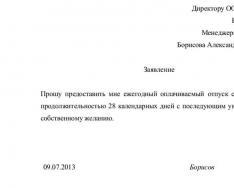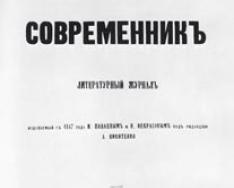All these questions concern not only novice personnel officers and accountants. Let's figure it out.
Situation 1. Vacation starts in December and ends in January
In this case, leave is usually issued (see). But we need to take into account that the “red” days (which are eight days in a row from January 1 to 8) are not included in the vacation; we jump over them, counting the calendar days of vacation.
Example.
You must provide leave for 14 calendar days from December 28. We count: beginning December 28, last day of vacation January 18. That is, the vacation will actually last 8 days more. Although we will accrue vacation pay for only 14 calendar days, since we provide vacation of exactly this duration. And we think so regardless of what schedule and mode the employee works.
Situation 2. Is it possible to provide vacation from January 1?
Yes, the Labor Code of the Russian Federation does not establish a ban on granting leave from a weekend or holiday. Annual leave can begin on any day established, even from January 1. But in this case, all days from January 1 to January 8 Not will be included in vacation days, they will be considered just days off and will be designated by the letter “B” on the timesheet
Example.
It is necessary to provide leave from January 1 for 20 calendar days. We count: beginning January 1st, last day of vacation January 28th. from January 1 to January 8, the report card includes days off, from January 9 to January 28, vacation days.
Situation 3. According to the schedule, working days fall on the New Year holidays. Is it possible to provide leave only for public holidays?
No, the law does not provide for such an option. If an employee wants to rest only for the New Year holidays, and you don’t mind, then you can provide vacation from January 1 to January 9. That is, it is necessary to include at least one non-holiday day in this period.
Example.
We provide annual leave for 1 calendar day from January 1st. We count: beginning January 1st, last day of vacation January 9th. The employee will actually rest for 9 days.
Situation 4. An employee fell ill on holidays while on vacation.
This situation often occurs in my practice. Apparently, the stress of the past year is taking its toll, or perhaps the overzealous approach to the new one. By the way, being sick on New Year’s Day is quite profitable - you receive both a salary for January and disability benefits for all the days you were sick.
Let's return to our situation. The employee fell ill, and part of the period of incapacity occurred during the holidays. How many days should the vacation be extended? Vacation is extended by the number of days in which the period of illness coincided with vacation. And since holidays are not vacation, they do not serve as a basis for extending it.
Example.
Leave was granted from December 28 to January 18. The period of incapacity for work is from January 3 to January 10 (8 calendar days). We extend the vacation only for 2 days, which coincided with non-holidays (January 9 and 10). The last day of vacation, taking into account the extension, is January 20.
In 2018, in different months, the preschool educational institution employed from 23 to 27 people, in 2019 - 27 people (of which one employee is on maternity leave). In what order should an institution submit to the Social Insurance Fund the information necessary for the appointment and payment of benefits for temporary disability, pregnancy and childbirth, the birth of a child and other benefits related to maternity: in electronic form or on paper (the institution is located in a constituent entity of the Russian Federation, participating in the pilot project)?
Changing the VAT rate in itself does not seem to cause difficulties for accounting employees. Indeed, you charge large amounts to be paid to the budget and that’s it... However, difficulties may arise during the transition from a lower rate to a higher one. In this article we will provide an overview of the latest explanations from officials on this topic related to the performance of work and the provision of services.
In April 2019, an error was identified: depreciation was not accrued for library collection objects accepted for accounting and put into operation in August 2018. What corrective entries need to be made in budget accounting?
From January 1, 2019, Russia is turning off TV broadcasting in analogue format. Citizens must ensure that their home has a TV with a built-in tuner or a special set-top box. This must be done today so that after the New Year holidays you will not be left without your favorite programs.
After information appeared that Russia would completely switch to digital television in 2019, people joked that they might be left without television broadcasting for the New Year. As it turned out, the joke actually turned into truth.
The government has long announced that the country will soon completely abandon analogue television. Such a transition was planned in the Federal Program for 2009-2015, but it was not implemented.
Now they say that from January 1, 2019, the country will completely abandon analogue television. In fact, citizens should not worry about the fact that they will not be able to watch their favorite programs on analogue air for the New Year. The transition will be gradual and will not affect all regions at once. Not long ago it was announced that analog television would be turned off starting January 10, 2019.
However, the Ministry of Digital Development and Communications warned Russians who use analog television that they need to worry in advance about buying a new TV or set-top box that will broadcast digital broadcasts.
How many days will be allocated for the purchase of a digital set-top box after January 1, 2019?
To switch to digital television, 10 days are allocated from the beginning of the year. This suggests that during the New Year holidays, citizens will still be able to watch analog TV, and after that they will need to buy a set-top box or a new TV. The department reported that regional companies themselves determine until what time they will broadcast on the analogue network.
The Russian Television and Radio Broadcasting Network (RTRS) reported that the transition to digital television has its advantages. Russians will receive many TV channels in excellent quality, comparable to those offered in paid packages. RTRS experts believe that there will be no special problems with the transition, since the cost of the set-top box is only 700-800 rubles.
What you need to buy to switch to digital television from January 1, 2019
As is already known, the transition to digital TV will begin after the New Year holidays, but you need to take care that the TV screen does not “go dark” today. If you are using an old TV, then you need to buy a set-top box.
In the store you need to purchase a set-top box that supports the DVB-T2 format. It's easy to customize. All you need to do is plug the antenna cable into a special connector and set up reception. The only drawback: setting up and switching channels is done using the remote control from the set-top box.
Modern equipment supports watching YouTube if there is Wi-Fi in the apartment. The set-top box has a USB connector for using a flash drive. You can also read data from memory cards.
In addition to such equipment, there are TV-Boxes and other set-top boxes of this type on sale that turn a regular TV into a Smart TV, but to use them you need the Internet.
Starting from 2019, serious changes await summer residents: the federal law on gardening and vegetable gardening comes into force. There will be enough innovations - starting from the abolition of the very concept of summer residents, ending with new principles of financial management. For more information about upcoming changes and what needs to be done before January 1, - in the material of YSIA.
Type of site
The new law leaves only two types of land use: gardening and vegetable gardening. Both provide for the use of the site for recreation and growing crops for personal consumption. But at the same time, it will be allowed to build not only outbuildings on garden plots, but also permanent residential buildings in which it will be possible to register. The concept of “garden house” is also introduced - new to Russian legislation; it means a building for seasonal use. Members of the gardening association will be able to build it without any special permits. It will not be possible to build real estate on a garden plot - the new law allows owners of this type of plot to build only outbuildings for storing garden tools and crops.
The procedure for recognizing a garden house as residential will be approved by the Russian government. Moreover, such an object will have to comply with the requirements established by the Town Planning Code for individual housing construction (a separate building of no more than three floors, no more than twenty meters high, which consists of rooms and premises for auxiliary use, intended to satisfy citizens’ household and other needs related to their residence in such a building, and is not intended for division into independent real estate).
If, before December 31, 2018, you register a building built on a site with the designation “residential” or “residential building”, from the new year these objects will be recognized as residential buildings. All other registered buildings (with the exception of outbuildings and garages) will be recognized as garden houses. Please note that registration of a house with an area of less than 50 square meters. m. is not required.
Partnerships
The old law allowed nine forms of associations of citizens to run subsidiary farming. Now only two remain - depending on the types of plots, gardening or vegetable gardening non-profit partnerships should be created. The law establishes that SNT or ONT is a type of partnership of real estate owners. The procedure for creating a partnership, membership in it, management and control is clearly stated.
Thus, the chairman, members of the board and commission will be elected for five years, and not for two years, as now. The maximum number of board members has been established - at least three people, but not more than five percent of the number of members of the partnership. For example, if the SNT has 200 members, the board can have a maximum of ten people. The partnership must have at least 7 members.
Settlements with the partnership
Starting from the new year, paying contributions in cash is prohibited; all payments by SNT members will be made through bank accounts. Neither the chairman nor the treasurer is allowed to accept cash from summer residents. This provision was introduced to provide greater transparency in payments and combat financial abuse. The partnership needs to appoint someone who will be authorized to open an account and represent the interests of the organization in a credit institution.
In addition, there are only two types of contributions left - membership and targeted. There will be no introductory, share or additional fees. Please note that previously paid fees will not be refunded. Gardeners and gardeners will determine the amount of fees and the procedure for spending them at a general meeting. Membership fees will pay for current expenses associated with the activities of the partnership, and targeted funds will be collected for the improvement and development of infrastructure.
Partnerships & Individuals
It is also possible to run a subsidiary farm without joining the SNT; this is not prohibited by the new law. However, if previously it was profitable to be an independent summer resident, since it allowed you to save money, now this advantage is lost. Any owner of a site will be required to pay for the use and maintenance of common property in the same amount as a member of the SNT. In case of refusal, the money will be recovered in court. If the partnership is not created in principle, each gardener independently resolves issues with organizations and authorities.
Let us add that previously, summer residents who were not members of a partnership could, at the discretion of the SOT, pay less. If SOT did not meet such “breakaways,” legal disputes over payment reached the Supreme Court of Russia.
Support from state authorities and local governments
The law contains a separate chapter on state support for gardening and horticulture. At the regional and municipal levels, special units can be created to supervise summer residents. The authorities have the right to organize the supply of public utilities to SNT and adopt support programs (including investment ones). At the same time, SNT are independent legal entities that freely carry out their activities.
What you need to do before the New Year
Reorganization of previously created partnerships as a whole is not required; it is enough to bring the charter and name of the partnership into compliance with the new law the first time changes are made. If in the extract from the Unified State Register of Land You indicate the type of permitted use - “garden land plot”, “for gardening”, “for gardening”, “dacha land plot”, “for dacha farming” and “for dacha construction” - your plot is considered a garden plot.
If the type of use of the plot is defined as “garden land”, “for vegetable gardening” and “for vegetable gardening”11 or for “gardening” as a type of agricultural production, your plot will be considered a vegetable plot.
The information can be found in your certificate of ownership of the land plot or you can request an extract from the Unified State Register.
Organizational work needs to be carried out, first of all, by the SOT chairmen. After the law comes into force, it will be necessary to determine a bank for settlements, distribute account details to all summer residents, re-elect the board and make changes to the constituent documents. To do this, it is necessary to organize a general meeting and resolve issues by voting. Decisions must be made by a majority vote of the partnership members.
Ideas

